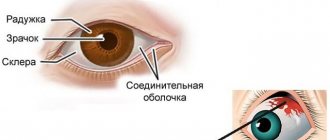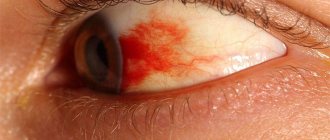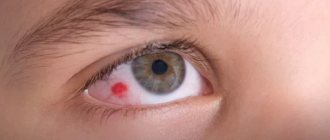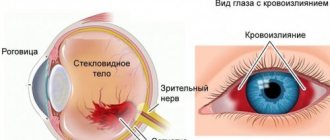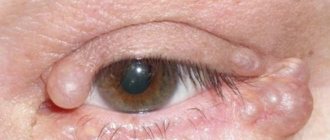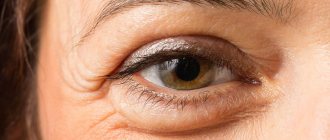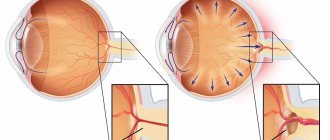When the whites of the eyes turn red, many people say that “vessels are bursting” in their eyes, but in fact the vessels rarely burst, and the reasons for this are quite serious. However, there are many other reasons why the vessels in the eyes turn red: these are diseases, overwork, injuries, taking medications, etc.
If red blood vessels often appear in your eyes, you should definitely see an ophthalmologist: perhaps it is an allergy, a reaction to contact lenses, or even an infection - self-medicating and using folk remedies in this case can be dangerous for your vision.
Capillaries in the eyes. Red capillaries in the eyes: causes, treatment and prevention
Everyone has heard more than once that eyes are a reflection of the human soul, but not only the soul, but also human health.
A person whose eyes are red looks very tired or sick. If a person notices redness, he should immediately contact an ophthalmologist. Perhaps it is an allergy, inflammation or infection. In order to return your eyes to their former beauty, you first need to figure out what is the reason for their redness. Usually people, seeing red eyes, say that a capillary has burst. But it is not so. After all, a burst vessel is dangerous, and this happens rarely. The capillaries simply fill with blood and become noticeable. It is strictly forbidden to treat your eyes yourself. And folk remedies would be inappropriate here, because it can be dangerous for your eyesight. There are many reasons why the capillaries in the eyes of a child and an adult are red. Let's talk about them further.
Common Causes
Causes of red capillaries in the eyes of a child and an adult:
- Inflammation. The most common cause is conjunctivitis (inflammation of the outer membrane of the eyes). Accompanied by redness of the eyelids. Sometimes the temperature may rise due to inflammation. You need to urgently consult a doctor and treat immediately. There are allergic, bacterial or viral inflammations, then it is contagious, and everyone around the sick person can become infected. You must follow strict hygiene rules, use only your own soap, wash your hands very often, use only your own towel, do not touch your eyes with your hands, because the infection will spread.
- Blepharitis is an eye disease that is accompanied by redness of the eyes and dilation of blood vessels. May be infectious or non-infectious. If it occurs, you need to consult a doctor and pay attention to personal hygiene.
- Episcleritis is a disease of the connective tissue of the eye. It often appears in women after thirty years of age. In addition to redness, there is also pain in the eyes, especially if you press on the eyelid. The reasons are different: infectious – tuberculosis, herpes, gout, rosacea; non-infectious - ulcerative colitis, Crohn's disease or lupus erythematosus.
- Keratitis is an eye disease that is accompanied by redness of blood vessels, inflammation, eye pain and fear of light. This disease of the heads is caused by vitamin deficiency, injury and infection. This is a dangerous disease, so you should consult a doctor immediately.
- Glaucoma is an increase in intraocular pressure.
What to do if hemorrhages appear too often?
Constantly recurring hemorrhages require a complete examination of the body. The pathology is probably caused by somatic diseases, ophthalmological diseases, and lack of vitamins.
Having discovered reddened sclera, it is recommended to perform the following actions:
- Pay attention to your diet. It should be dominated by foods rich in vitamin C and rutin. There are many of them in citrus fruits, lettuce, bell peppers, and spinach.
- Colds are treated with antiviral drugs. They do not destroy small capillaries.
- Limit trips to the bathhouse or sauna.
- Spend less time under the hot sun and wear sunglasses.
- Reduce physical activity, do not lift heavy objects.
- Rest your eyes every hour when working at a computer for a long time.
- An air-conditioned room must also have a humidifier.
A person’s life will not change for the better if the organs of vision do not function normally. Deterioration of vision can be prevented by regularly visiting an ophthalmologist, especially for people over 40.
Red capillaries in the eyes of a child. Why do capillaries burst in a child's eyes?
When a child has a blood vessel burst in his eye, there are many reasons. Children actively explore the world around them. They undergo the formation and development of organ systems, including the nervous system. Injuries, tears, and illnesses often occur. This can cause bleeding in the baby's eyes. Let's look at the most complete list of reasons:
- Strong crying. Anguished crying causes high pressure on the capillary wall. This problem most often occurs in infants - after crying for a long time, mom and dad notice that a capillary has burst in the baby’s eye.
- Colds. Causes: cough, nose blowing, elevated body temperature.
- High load on the organ of vision. When children spend a lot of time playing computer games, using a smartphone, watching TV, or wearing incorrectly selected glasses, a capillary can burst from overstrain of the visual organ.
- Foreign bodies. Due to irritation and rubbing of the eyelids, damage to the vessel occurs.
- Constipation. When the baby strains, the wall of the capillaries bursts from tension.
- Ophthalmological diseases: infectious and non-infectious (allergic, systemic vasculitis). A common cause is conjunctivitis, bacterial, viral or allergic.
- Somatic diseases (hypertension, diabetes mellitus). Due to damage to the vascular wall, the capillary may burst.
- Traumatic injuries, burns. The reason is mechanical trauma to blood vessels.
- Hormonal changes in the body during puberty.
- Fragile vessels. A vessel may burst due to a lack of vitamins or as an individual feature of the baby’s vascular system.
- Contact lenses. If the rules for wearing lenses and caring for them are not followed, the vessel may burst.
- After passing through the birth canal, you can see that a capillary has burst in the newborn’s eye. By the time of discharge from the hospital, resorption occurs.
Red blood vessels on the whites of a child's eyes. Causes of red blood vessels on the whites of the eyes in children
There are many reasons why the vessels in the eyes turn red: infectious diseases, allergic reactions, injuries and foreign objects, increased intraocular pressure, and in older children - simple fatigue.
Conjunctivitis in a child
The consequence of inflammation of the mucous membrane of the eyes is most often insufficient hygiene of the child’s hands, especially during the hot period, favorable for the rapid proliferation of pathogens.
The main pathogen is staphylococcus, which gets onto the mucous membrane of the eye from the hands along with street dust when the child begins to rub the organ of vision.
In addition to bacterial, viral and allergic eye conjunctivitis also occurs.
Main symptoms:
- redness of the mucous membrane of the eye;
- swelling of the eyelids;
- the appearance of visible small vessels in the visual organ;
- profuse tearing mixed with pus.
Sometimes inflammation of the mucous membrane of the eyes is accompanied by a sore throat, enlarged cervical lymph nodes, and fever. The child becomes lethargic and is irritated by daylight, causing pain in the eyes.
Allergy with redness of blood vessels in infants
Another cause of red blood vessels in the eyes of children is an allergic reaction.
In this case, specific treatment is usually not required; it is enough to eliminate the allergen.
Allergies can be caused by dust, pollen, pet hair, medications, washing powder, and household chemicals.
Infants sometimes have an allergic reaction to nicotine, especially if they smoke indoors, or to fragrances found in powders, soaps and other baby cosmetics. If you cannot independently determine the type of allergen, you must contact a specialist.
Foreign objects and injuries
Injury or a foreign object entering the visual organ can also cause redness in a child. The discomfort that the baby experiences from the sensation of a foreign body forces the child to continuously rub his eyes, which causes redness of the blood vessels.
If a child complains of unpleasant sensations, you should carefully examine the organs of vision and whites, alternately moving the upper and lower eyelids. You can try to remove a detected foreign object by rinsing it with cool boiled water or with a corner of a clean handkerchief, previously ironed and soaked in boiled water. If the attempt is unsuccessful, you must consult a doctor.
Increased intraocular pressure
Straining the eyeballs during movement along the birth canal sometimes causes rupture of the optic vessels in the newborn.
According to statistics, with a normal birth, 20% of babies are born with such a problem, and with problematic ones - already 40%. In the maternity hospital, the ophthalmologist will give the necessary recommendations.
Damage to blood vessels occurs in infants due to severe crying or coughing; in this case, the baby should definitely be shown to a doctor.
Increased intraocular pressure in a child is an indicator of some forms of primary angle-closure glaucoma.
If, in addition to reddened blood vessels in the eyes, the baby complains of eye and headache pain, flickering rainbow circles, or a slight decrease in vision, it is necessary to consult a doctor as soon as possible to make an accurate diagnosis and start treatment as soon as possible.
What is not advisable to do if a blood vessel bursts?
Some, having encountered this problem, prefer to deal with it using various methods, which aggravates their situation and leads to a deterioration in the condition of the eyeball.
What absolutely should not be done in the event of a capillary rupture:
- Use vasodilator drops. They do not help, but harm the eyeball and provoke the appearance of spots.
- Rinse your eyes with tea. Tea does not relieve inflammation, but promotes the development of conjunctivitis.
- Neglect the rules of personal hygiene. Wash your hands often, don't touch your eyes, get plenty of rest.
If you are sure that the cause of the red eye is an internal disease of the body, then go to the doctor for a diagnosis and treatment.
Red blood vessels in the eyes drops. What are firming eye drops and how do they work?
Through the eye vessels, all elements of the visual organs are nourished: optic nerves, retina, lens, etc. If for some reason the blood vessels weaken, the first thing that happens is blood circulation. The eye tissue no longer receives the required amount of oxygen and nutrients. Metabolic processes are disrupted, as a result, pain and discomfort occur, and vision decreases. As a result, the vessels weaken even more and eventually burst as soon as they are filled with so much blood that they can no longer cope.
Weak blood vessels need support in the form of fortified drops for external use, they will help prevent complications
If you have red blood vessels in the eyes, redness of the mucous membrane or whites of the eyes, pain and discomfort, you cannot do without strengthening the eye vessels. The process is aimed at restoring damaged capillaries and normalizing blood circulation. This effect is achieved with the help of vitamins and minerals, which are the main components of ophthalmic drugs of this group.
Here are the vitamins that are primarily necessary for strong and healthy eye blood vessels:
- Vitamin A. Helps restore blood circulation, protects and renews the epithelial layer. But at the same time, vitamin A must be supplied to the body in a strictly dosed manner; its excess is just as harmful as its deficiency.
- Vitamin C. This is the most accessible antioxidant, it accelerates blood circulation, protects cells from free radicals, and strengthens nerves. It is not difficult to obtain from food, but nevertheless, most people suffer from its deficiency.
- Vitamin B. This refers to a whole group of vitamins, the lack of which seriously affects the skin and mucous membranes, impairs blood circulation, which leads to the development of spasms and convulsions.
Also, vitamins P and E are important for the eye capillaries, as for any other vessels. They help thin the blood, improve microcirculation and prevent the formation of blood clots.
Thus, eye drops that strengthen blood vessels act in several directions at once: they restore impaired blood circulation, make the walls of blood vessels less vulnerable, nourish tissues with vitamins and normalize metabolic processes.
Dilated vessels in the eyes of a child and an adult: causes and treatment
Dilatation of the blood vessels of the eye (fundus) is an ophthalmological disorder, which is scientifically called “eye injection”.
This condition is characterized by redness of the conjunctiva, which can often be described as “burst of blood vessels.” This concept applies to both children and adults.
In fact, they burst in rare cases and under enormous loads or serious pathologies, but dilation of blood vessels or veins can occur quite often for a number of reasons.
How are the blood vessels in the eyes arranged?
Reference! Like any other organ of the human body, the eye is penetrated by a network of blood vessels, which serves to deliver nutrients and oxygen to tissue cells.
If a disruption or damage occurs in any part of the vascular system, the functioning of the organ of vision as a whole also malfunctions, but given that this network of the eyeball is quite extensive and branched, even with damage, functions are sometimes not lost.
Blood enters the vascular system of the eyeball from the carotid artery through the ophthalmic artery.
The latter, in turn, feeds the entire ocular apparatus.
But the most important are the vessels and capillaries responsible for the delivery of nutrients to the optic nerve and retina.
These are the central retinal artery and the ciliary arteries. If the disturbances in them are irreversible, vision will be lost irrevocably.
Possible causes of dilated blood vessels in the eyes
Vasodilation can only occur due to the fact that a person has undergone unusual or excessive physical activity.
Note! But often this symptom is a sign of pathological conditions and ophthalmological diseases:
Children may also experience such disorders for the same reasons.
But sometimes the expansion can be a consequence of blockage of the lacrimal canal - a pathology that is often found in newborns and is almost never diagnosed in children over 3-4 years old, and especially in adults.
Treatment options
Keep in mind! If redness of the eyes caused by this disease is observed constantly, this is a reason to consult a doctor, who, based on the diagnostic results, will prescribe appropriate medications.
In this case, the following products are usually used, which are available in the form of ophthalmic drops:
- Vasoconstrictors. These drugs quickly tone the system, but the use of such drops cannot be long-term. Over time, the tissues begin to adapt to the active ingredients of such drugs and stop contracting, as a result, the eyes remain red due to dilated blood vessels for life. The most popular vasoconstrictors drugs – naphthyzin, visine, octilium.
- Antihistamines. These are drugs designed to relieve inflammatory processes in the tissues of the eye, including in the blood vessels. They can be used not only for allergies, but also for severe inflammation. Among such drugs are Allergodil, Cromohexal, Lekronin.
- Vascular preparations with the inclusion of vitamin compounds. Such drugs mainly play a preventive role if the onset of degenerative processes that can lead to this pathology is suspected. Such drugs are taufon, riboflavin and taurine.
If the vessels dilate due to bacterial damage, the ophthalmologist prescribes antibiotic drops: chloramphenicol, albucid, vitabact.
Prevention
It is worth noting! Prevention of this disease comes down to strengthening the vascular system. To do this, just follow the following recommendations:
- limit physical activity, especially without appropriate training;
- pay attention to symptoms of increased intraocular pressure and contact an ophthalmologist to eliminate this problem;
- add more foods containing vitamin C to your diet;
- If sand or small foreign bodies get into your eyes as a result of being outside in windy weather, your eyes should be rinsed with running water as soon as possible;
- if the eyes begin to turn red after visiting the bathhouse or sauna, this indicates the predisposition of the blood vessels to hemorrhages at elevated temperatures and humidity, therefore, such activities must be limited;
- When working at a computer and reading, it is necessary to ensure sufficient lighting in the workplace, and after every hour or two, take short breaks.
Some preventive measures
Knowing the main causes, you can carry out effective daily prevention, which will help minimize the risk of minor hemorrhages:
- Introduce into your diet as many vegetables and fruits rich in vitamin C and rutin as possible.
- Limit the consumption of drinks that increase blood pressure.
- Avoid alcohol and nicotine.
- Alternate computer work with eye exercises.
- Protect your eyes from bright sunlight, mechanical damage, sand and dust.
